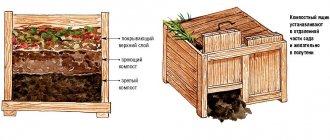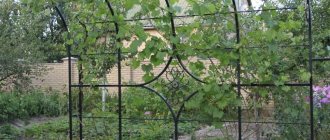How to tie roses to a support
Rose support
It is best to give the shoots the desired shape in advance to avoid additional worries. You need to immediately install a support when planting a seedling. This will eliminate the possibility of damage to the developing root system of the plant.
Note! You can give any direction to the stems, trying to get the maximum decorative effect. There are several options for how to secure a climbing rose:
There are several options for how to secure a climbing rose:
- Horizontal garter - on a lattice or trellis;
- Spiral - tying a pole or other vertical support;
- Vertical - along tree trunks, arch columns;
- Fan-shaped - next to a wall or hedge.
Expert recommendation: how to tie up climbing roses:
“In spring, climbing roses definitely need time to set buds on horizontal shoots. There is no point in rushing to lift it from the support. You need to wait some time for the buds to appear up to 3-5 cm on second-order shoots. Once I tried it without waiting for the young shoots to grow and decided to attach them to a support. As a result, the entire pipe was practically bare: there was no flowering. Once again I was convinced that I need to wait until the buds swell.
When placing climbing roses on a support, it is necessary to take into account that the planting of pink shoots occurs at an angle of 30 degrees. In accordance with this, they are placed on supports.
In the case of a horizontal arrangement, the growth of lateral branches, which are absolutely unnecessary in this case, will increase.
Additional Information! When the branches are directed at an angle, in a spiral shape, this promotes better formation of buds. Flowering lasts a long time.
When climbing roses are arranged vertically, it will be necessary to artificially create branching, because the flower will grow in length. Here it will be necessary to bend the top of the plant down to change direction.
A rose bush can be shaped like a fan, which will become a screen, partition, or act as a decoration for walls or fences.
Climbing rose on the partition
What are they for?
Rose shoots do not climb without a supporting structure. The support allows you to correctly direct the shoots, form a beautiful bush, and create an interesting landscape composition.
Climbing roses are a popular garden decoration option. However, in an improperly fixed plant, buds appear only in the upper part of the bush. The shoots are placed on a support so that they, for the most part, run horizontally. Then the appearance of buds on the bush will be uniform.
Inexperienced gardeners believe that climbing roses can be planted against a wall or fence so that the plant can cling to protrusions and uneven surfaces on its own. But the lack of high-quality support negatively affects the appearance of the plant and flowering.
Types of supports
Climbing beauties need support. The following can serve as supporting structures:
- walls;
- columns;
- obelisks;
- cones;
- frame;
- prop;
- arches;
- gratings;
- wigwams;
- pyramids.
Supports are made from a variety of materials, it all depends on the budget of the owners
Before you make it, it is important to consider the following aspects:
- The support must be made of durable materials that can withstand any weather changes.
- It is necessary to clearly determine the place for support, understand the methods and fastening scheme.
A vertical support would be ideal for a climbing rose. The plant will cling to it with tendrils and weave towards the sun, reaching up to 4 m in height. Note that such supports can be used not only for roses, but also for other climbing plants. Read more about growing garden morning glory here.
Trellis net
You can easily make such a support yourself. To do this, you need to dig in pillars made of wood or metal at the required distance, then stretch the mesh. To ensure that the structure fits perfectly into the design of the site, it is better to paint the pillars in a suitable color.
Trellis net
The trellis can be made from wooden boards, securing them with a mesh between the beams. A similar design for a climbing rose will allow you to form a spectacular bush.
Arches and pergolas
These designs are an ideal solution for arranging spacious summer cottages. Arches and pergolas can also be made with your own hands. Pergolas are a lattice roof fixed on poles. The dimensions of such a support are calculated individually and depend on the design idea. The posts can be wooden or metal. The advantage of a pergola is that this support can also serve as a gazebo. You may also be interested in the technology of constructing a summerhouse from laminated veneer lumber; see details here.
Pillars with supports
You can also make such supports yourself from wooden or metal rods and poles. The pillars for creating supports are very convenient: compact, not very wide. They are often used as supports for roses that climb slowly. Any poles are suitable for a climbing queen: in the form of a column, cylinder or cone.
Climbing roses have neither tendrils nor suckers, so they will not be able to grow upward without additional supports.
In order to build a cone-shaped support, you need to install several wooden rods or beams in a circle and connect them at the top. This stand is suitable for any climbing flowers.
Other types of metal supports
There are many other varieties of supports for climbing roses. Let's consider a few more options:
the “striving upward” support has the shape of a tower and is made of a metal base; Inside the structure there is a stand for a container in which the fragrant flower will grow. Such a “tower” will look especially good on an open terrace;
Metal support
- metal column: versatile and reliable. As a rule, it is made of galvanized steel, which turns it into a structure that is quite strong and resistant to the damaging effects of the environment.
- “Eiffel Tower”: this support consists of crossbars with an openwork structure, ideal for the side shoots of a rose.
- flip bars: they can be placed on both sides of the track. A natural corridor is created, the roof and walls of which will be gracefully entwined with roses. If you also install benches, then such a flowering support will create a cozy place to relax.
- wigwam support: suitable for a garden decorated in Indian style. To do this, you need to weave a cone from willow or birch bark with a sharp crown, which the roses will reach with their shoots.
- “Steel obelisk” is a support made of pipes. Ideal for roses with a leisurely growing season.
Tips and tricks from experienced flower growers and gardeners
Stone, wood, plastic and metal are used as support for climbing roses. Several factors influence what the frame for the plant will be made of: garden design, price of materials and construction, type of flowers.
Horizontal bars should be placed at a distance of 50 cm from each other. Additional crossbars are made if the bush is highly branched.
Note! Large supports with spherical shapes are perfect for bushes with large inflorescences. Vertical supports are suitable for small inflorescences
For a minimal investment, the plant can be planted near a fence or shed. They will serve as a support for the plant. To prevent the plant from becoming infected from the support, it must be painted and varnished.
Instead of a trellis, you can use a fence
Regardless of the type of support, first of all it is necessary to plant the plant correctly and care for it so that it grows and rises along the manufactured arches.
The climbing rose is widely used to decorate garden plots, however, if it is not properly mounted on a trellis or support, flowers will appear only at the top of the bush. The plant needs to be shaped so that as many branches as possible are in a horizontal position, then the gardener will receive beautiful rose bushes with abundant flowering.
vote
Article Rating
Subtleties of caring for planted bushes
Caring for rose bushes involves watering, fertilizing and pruning. After flowering, you need to cut off the faded inflorescences so that the rose does not lose strength to set seeds. Water rarely, but abundantly, once every 7-10 days.
In the first year, the plant will use the fertilizers provided during planting. Then you will need fertilizing approximately 3-4 times per season: 2 times in the spring, before flowering, 1 time after flowering and at the end of summer.
- After flowering, feed with infusion of horse manure or complex fertilizer for roses with microelements. Wood ash is added under the bushes to speed up the ripening of young shoots.
- From mid-summer all feeding is stopped. Otherwise, many young shoots will grow that will not have time to ripen by winter. Under cover they will begin to rot, and the rose will not survive the winter well.
- At the end of August, phosphorus-potassium fertilizers can be applied to the roses.
It is necessary to carry out annual pruning of shoots for proper formation of the bush. With good care, the lashes grow 2 meters during the season. For the winter, the rose is removed from its support, bent to the ground and a shelter is built for it.
Pergolas
Initially, the pergola had a very practical purpose and served as a support for grapevines with heavy, pouring bunches. Over time, this design, which came from the Mediterranean, has become popular all over the world and is increasingly of a decorative nature. Although at first pergolas were built as large canopies, now on our sites their sizes can change at the request of the owner.
Essentially, this is an open veranda, attached to the house or separate, in which some of the openings are filled with a thin lattice, beams, curtains, and the role of the roof is played by weaving plants. Building a pergola is quite simple - you need to make a wooden frame from a powerful beam, optionally covering some walls with screens or partitions. Then plant grapes, virgin grapes, clematis, climbing roses and other plants that winter in your area without shelter at the pergola supports. In a few years (provided there are mild winters), a real Mediterranean pergola will decorate your site.
Tips from a landscape designer
To improve your garden plot and create a truly beautiful composition of climbing roses, it doesn’t hurt to follow the recommendations of experienced landscape designers:
- It is advisable to make cross bars on poles only if the plant has a lot of branches.
- Large, massive supports are combined with bushes that produce large buds. And narrow, vertically oriented products are more suitable for varieties with small flowers.
- The support should be installed before the bush is planted. If you do the opposite, the installed structure will injure the roots of the plant.
- The shoots will curl in a chaotic manner if they are not directed. Therefore, the owner must constantly shape the bush and secure the branches in the right places.
- Withered flowers are cut off to encourage new buds to form.
- If roses are planted along a fence or wall, then the supporting surface is coated with paint or varnish. This will prevent possible infection of the shoots.
Experienced gardeners advise regularly pruning roses and applying mineral fertilizer. Without these procedures, it will not be possible to form beautiful, lushly flowering bushes.
Types of supports for climbing roses
The design options that you can make yourself are varied. Among those that will be within the capabilities of a site owner who does not have construction skills are:
- vertical stands;
- pyramids and columns;
- stairs;
- arches and pergolas.
By combining several different designs, you can unusually design a gazebo, fence a plot or any area, create an impressive backdrop for a flower bed, or cover up an unsightly wall of a country house.
Any type of vertical gardening includes the use of frames for climbing plants. The support for the roses must be made taking into account the fact that the bushes do not have tendrils to independently fasten to it, they do not wrap around vertical elements and cannot weave along it independently. The stems will have to be tied up as they rise. In central Russia and to the north, it is necessary to provide for the possibility of easy cleaning and shelter for the winter.
The frame must be installed before planting the bush in the chosen location. During the installation of the support, excavation work will have to be carried out, and the roots of the roses may be damaged.
Trellis-mesh for lashes
A trellis is a flat vertical canvas on which the stems will be attached. Similar walls can be installed around the perimeter of the fence or a mesh can be secured between the corner supports of the gazebo. Varieties of trellises are also used for finishing the facade. When using this method, it is recommended to maintain a gap of 15-20 cm between the mesh and the wall to provide the bushes with air access from all sides.
Semicircular trellis for climbing roses.
Stands made of wide wooden planks mounted on a frame look decorative. Craftsmen can independently assemble a forged or bent metal structure. The design of such a trellis complements the green leaves and bright spots of flowers. Large trellises are often painted in colors that contrast the shade of the foliage, and no effort is made to make it invisible.
A variation of such a structure is a trellis for climbing roses with a chain-link mesh or plastic garden lattice. These types of materials do not stand out among the branches and create the effect of a green wall of vertical stems. You can replace purchased material with thin steel wire or durable nylon cord. The mesh fabric is fixed on vertical supports.
Arches and pergolas in the flower garden
An arched metal or wooden support can be installed near the garden gate. This will immediately create an atmosphere of transition from the paved courtyard area to the green area. A pergola differs from an arch in that it has a flat top and is more like a canopy. Both structures are convenient for installation above benches in a recreation area.
Arches for climbing roses can also be made in a flower bed. In a flower garden, such a support will create an expressive accent. To pad it, you can plant low and medium-sized shrubs or coniferous crops next to the arch entwined with flowers.
Arches and pergolas in the garden.
A pergola or arch consists of 2 parallel lattice walls, to which the lashes of roses are tied. You will need to install a roof over the walls: flat for a pergola or semicircular for an arch. All structural elements can be manufactured according to the principles described for the lattice stand:
- from a bar or slats;
- from bent metal rods imitating forging;
- made of mesh stretched over pillar supports.
If you place several arched elements next to each other, you can build a green tunnel. Under a roof of pink stems and leaves, it will always remain shaded and cool.
Cone supports and pillars
This type of element is designed to give the bushes a compact and impressive look. It is convenient to install pillars, pyramids or cones in a small flower garden, where spreading bushes will take up too much space. A decorative green pyramid can look original on a lawn, creating a bright spot on a green background. Inside a high pyramid (more than 2 m), you can make a gazebo if you use several bushes planted around the perimeter of the building for landscaping.
Supports for climbing roses.
A climbing rose on a support of this type serves as a design element itself, and does not complement the structure. It is advisable to make the sides of a garden pyramid from durable but inconspicuous parts (metal rods, wooden slats, rigid galvanized mesh, etc.). Spreading bushes need to be secured so that the branches of the rose climbing along the frame cover the base as much as possible.
Making arches and pergolas
Pergola is a lattice on poles in the form of a roof. Can serve as a gazebo.
- Dig in metal or wooden poles by digging a hole at least half a meter deep.
Length, height and width are selected according to the type of plant. For large-sized roses, two-meter poles with a diameter of 15-20 cm are suitable. For small species, half-meter posts are sufficient. - Above the posts, build a metal lattice from thin rods with a diameter of 1-2 cm to form large squares of 30 cm. This will allow the plant to grow unhindered. The rods are welded together and placed on top of the posts and securely fastened with 150 mm nails or 75 mm self-tapping screws.
Arches come in a variety of curved shapes . They are designed for large varieties of climbing roses that can reach the top as they grow. Arches are wonderful decorations for entrances and garden paths. They are forged and wooden. They are also dug into the ground and plants are planted at a distance of half a meter from the structure.
We invite you to watch the video instructions for making an arch:
DIY arched pergola for climbing roses
A pergola can serve as a tent or garden gazebo.
An exceptionally spectacular element of garden decor is a pergola covered with roses. You can also build it yourself:
- dig wooden beams or metal poles in increments of 1.5-2 m in two rows - opposite each other;
- tie them together with a lattice of slats or metal rods;
- tie the rows together with the same lattice on top.
Roses are planted on the outside of the rows and directed up the trellises. After 3-4 years, long-climbing ramblers are able to completely cover the pergola.
A pergola allows the landscape designer's imagination to run wild. For example, in this way it is possible to assemble not a continuous tunnel, but a series of wide arches, slightly spaced from each other. This option is good because it does not create a large shading area.
Another effective option for using a pergola is to create a decorative porch in front of the entrance to the house. You can also use it to successfully design a summer veranda.
Tip #2. There is no need to buy any expensive material for a pergola. Today, the rustic style is very popular in landscape design. Its peculiarity is the use of natural materials with minimal processing. For a pergola in a rustic style, for example, large branches of garden trees roughly tied together after pruning are suitable.
DIY rose arch: detailed guide, diagram
How to plant a rose
On a note! The arched option is very suitable for garden design. The arch itself fills the space with a certain mystery and elegance. When there are climbing roses on it, it is an unforgettable view.
Most often, arches for climbing roses are placed near the entrance to the yard. This is not the only place where she will “fit in.” An excellent location would be next to the gazebo. Arches are usually made of wood or metal. There is also a plastic option. The strength of this material leaves much to be desired. The most durable are forged arches. They are mainly used as a support for climbing roses.
In order to make a support with your own hands, you need to decide on its purpose. You can pre-create a drawing. Will it serve only as a decoration in the flowerbed or will it be an entrance, a place to relax. The purpose is taken into account when choosing the material and thickness of the bases and transverse slats. Below are recommendations on how to make a climbing rose arch with your own hands.
Algorithm for creating an arch with your own hands
You will need the following fittings: rods with a diameter of at least half a cm. As a rule, a pair of rods is used. It needs to be bent in an arc and dug into the ground to a depth of half a meter; Between a pair of rods it is necessary to fasten special metal rods. It is more convenient to attach to a wire. This makes it easier to tie the plant in the spring, and also more convenient to remove when autumn comes; It is necessary to paint all the parts of the arch before installation. Have rods with a diameter of approximately 0.6 cm. As a rule, 2 rods are used as a base. They are given the shape of an arc and then dug into the ground to a depth of 50 cm; The number and length of the beams depends on the structure of the arch
It is important to firmly fasten the beams together; The result is a ladder. To create an arch you need two of them
On top of the arch - attach small beams; The wooden frame must be varnished.
Arches, trellises or ladders: what to choose?
Gardening centers offer various ready-made design solutions for vertical gardening:
| Design form | Peculiarities | Approximate cost, rub. |
| Arch | They are made of metal and may include forged decorative elements. Suitable for landscaping with rambler roses. | 12000 |
| Trellis (lattice panel) | They do not exceed 2 meters in height. The standard width of one span is 1 meter. At least two spans are usually purchased for roses. Suitable for landscaping using climbers. They fit worse under ramblers - only when launching lashes in a horizontal direction. | 5700 for 1 flight |
| Ladder | Narrow design, about 40 cm wide. It can be classic wooden or forged, figured. Height no more than 2 meters. Suitable only for hanging the rambler on the wall, after which the lashes will require additional support and garter. | 500-3000 |
| Lattice screen with flowerpot | They are a wooden or plastic trellis with a lattice, in the lower part of which there are boxes for planting plants on both sides. Suitable for container growing of climbers if the box depth is at least 60 cm and the screen width is at least 2 m. | 8000-12000 |
| Pergola | A lattice arch for creating flowering tunnels, at least 140 cm wide. Can be wooden or metal, with forged elements. Suitable for landscaping with ramblers. | 4500-15000 |
Climbing roses provide good shade, but they themselves need enough sunlight.
The location of supports for climbing roses depends on the design intent of the grower. This way you can design the entrance to a site or a house, create an arched tunnel over a path, or place a support with a rose as the central figure in a rose garden.
The illumination of the area where the climbing rose will be located is of great importance. It is necessary to choose the brightest place, protected from cold winds, since in the shade roses bloom worse and grow more slowly.
Trellis for flowers
For flowers, the easiest way is to make a rectangular wooden trellis
The dimensions of the device can vary at the request of the developer, but you should always take into account the size of the flower
Trellis can be made from any available materials, which are quite durable and can last as long as possible.
In addition to its relatively good strength, a picket fence trellis can look great not only with flowers blooming on it, but also in early spring or late autumn, when there are no bright leaves and flowers yet.
To make a trellis from such material you will need:
- Screwdriver or thick screwdriver.
- Skin.
- Level measuring device.
- Paint brush.
Usually a height of half a meter to two is sufficient, but you should always be guided by the maximum possible height of the plant. It is necessary to select the material of the required length so that you do not have to additionally shape the tree. If the pickets are not planed properly or have jagged edges, they should be smoothed out using sandpaper.
One pair of parallel slats will lie on the plane, providing support for the other two attached to them and for the entire structure. Another is applied to one of the slats, next to which the second is placed. A third is attached to it, which is secured at two opposite ends. Next, two more are attached closely to the beam secured with screws, and the third, which is located next to them, is attached again. Two slats constantly act as delimiters, helping to measure an even distance between adjacent fixed slats.
After finishing work on the first row, the structure is turned over, after which the same construction activity is carried out with parallel bars. As a result, an even diamond-shaped wooden sheet is formed.
To give a representative appearance to the trellis and protect the wood from moisture, varnish is used. They cover all the wood with at least 2, preferably 3 layers. The trellis can be installed in a predetermined place after the varnish has completely dried.
If you use a house wall or a fence for support, you need to attach the trellis to a flat surface not tightly, but using wooden blocks that are placed on at least four sides.
On average, one grid will require:
- About 50 wooden planks.
- About 100 screws or nails.
- 2-3 cans of varnish.
And here is an article about how to make a rock garden yourself.
Ideas for supporting clematis
A support for clematis does not have to be made according to certain standards and purchased at a construction supermarket. You can make it yourself, using unnecessary materials, for example, the remaining piece of chain-link mesh.
Chain-link mesh is a fairly durable and easily formed material. You can use it to make figures that will later decorate the garden, or attach it as a wall mount for a climbing plant.
The second material after galvanized mesh is usually wooden structures constructed from the remaining building materials: planks, slats, pegs.
And finally, the most popular solution is to let clematis grow on the walls. The climbing plant clings with its shoots to any protruding area. Thus, residents of private farmsteads often plant clematis along the partition walls separating their personal territory from the neighbor’s.
A win-win option for planting clematis is the porch of the house and its walls. Columns and railings will become a strong support for the branchy perennial.
A climbing plant will look harmonious in pots displayed near the house. Sometimes it is replaced by grapes, which also frame the space with a green crown.
DIY openwork support
In order to build a good metal structure for climbing roses, you need to decide on the location, shape and material. The metal pergola looks the most interesting and is distinguished by its durability. It can be made from fittings and pipes of various diameters.
When choosing a shape, it is necessary to take into account that the width of the building should be greater than the height. Narrow and high pergolas are unstable. The most stable is a square or wide arch. The flexibility of the pipes allows for the production of bores of various configurations. You can weld curved rods in the shape of any animal or ball, placing it comfortably on the lawn.
To make the base, round or square profile pipes are used, cut and connected to each other by welding. In the gaps you can put wire or rods of various diameters.
A pergola made of metal with your own hands can be stationary or portable. In the first option, a foundation is poured under the metal structure with the installation of pipes or fasteners for them, and the foundation is prepared.
They use a stationary installation for gazebos and canopies. Climbing roses and clematis are planted from the outside and trail along the trellises between the pipes. When the plant does not completely cover the support area, it has a very attractive appearance.
In the second case, the base is welded so that the metal structure is rigid and does not deform when moved from place to place. Typically, when moving and installing on a new site, several types of fasteners are used. The most reliable and simplest is reinforcement driven into the ground and the base of the metal structure tied or screwed to it.
The diversity in the implementation of elements of design ideas does not exclude the combined implementation of garden decoration. These include:
- metal - wood;
- metal - stone;
- tree - stone.
Fences and canopies look especially beautiful, made in a mixed style and braided with lovely roses and clematis.
Types of flower supports
Types of supports for climbing roses.
Supports for roses can be divided into two types: natural and artificial.
The first type includes landscape objects such as trees or stones. The second type is more diverse in its variations: you can change not only the shape of the support, but also the material from which it is made.
Steel wire can become a durable support for a climbing rose. Its service life is about 15 years. A wire net will not only allow the roses to grow in the direction you want, but will also allow air to circulate quietly within the structure. The best thing is the ability to create any size and shape of the network. Of course, working with such material will take time and a little magic with pliers, but the result is worth it.
A less durable support would be a wooden lattice. Although she has her own charm and charm, she will not serve her owner for more than 10 years. They like to use such a support as an addition to a gazebo or as a divider of the garden into several zones. It’s quite easy to make it yourself from scrap wood and boards—you just need a little skill and diligence. It is better to treat the wood before use, otherwise it will become unusable too quickly. Keep in mind that a wooden structure will not stand strong enough, so it will have to be attached to something heavier.
Arches have always been a very popular support. They visually divide the area into two parts and give it a luxurious look. In order for the arch to suit your site, you need to select the material.
Scheme of planting roses to a support (house wall).
Metal arches serve their owner for a long time, but to make such a structure, you need to be able to use welding equipment.
In warm regions you can find arches made of plastic pipes, but it’s worth mentioning right away that this is not recommended for Russia, since plastic cannot withstand low temperatures.
A stone support for flowers is the dream of romantic young ladies. Scarlet roses against the background of a gray arch are reminiscent of old stories about knights and princesses. This is a strong and durable design, but it is only suitable for large areas. In small gardens such an arch will look heavy.
Of course, you can buy a ready-made rose support. It doesn't have to be an arch. Trellis or rectangular screens will look quite organic. The main thing is that the height of the structure is at least 1.8 m. The materials of the finished supports also vary from cheap plastic to expensive metal structures.
The role of support
A support for a climbing rose is a necessary structure, without which the flower will not climb. Depending on the type of stand, you can independently build a decorative composition, set the direction of growth, and give it shape.
Climbing roses are a good option for creating flower beds and hedges in the country.
Any structure can be used as a support for a plant, the main thing is that it meets all the necessary requirements. The support for a climbing rose must meet the following characteristics:
- Reliability. This is the main functionality of the stand. It must be strong. Gardeners often make the mistake of thinking that a rose is a light plant. This is wrong. Blooming flowers and developing shoots have a lot of weight. Therefore, the rack must withstand heavy loads. To achieve this, you need to use only high quality materials in production. To ensure stability, it is recommended to bury part of the support in the ground.
- Compliance with environmental regulations. Any support for a plant must be safe for the environment. Therefore, you need to give preference to environmentally friendly materials.
- Easy to use. It is not recommended to make supports multifunctional. Complex structures will spoil the appearance and take up a lot of space on the site.
- Aesthetics. Despite the fact that the main role of the support is to provide support to the plant, the structure must be attractive in appearance. It is advisable to choose a stand that fits beautifully into the overall style and landscape of the site.
Important ! The dimensions of the stand should be selected taking into account the dimensions of the bush. If the support is too small, it will not be able to perform its functions. Conversely, using a bulky structure for a small shrub will result in the support standing out strongly in the area.
The plant support must be strong
Leading rose lashes along the wall of the house
If the lashes are tied to hooks, aeration is ensured by a sparse, “mesh” arrangement of the lashes.
This option is suitable for both ramblers and climbers. The only difference is the height of the structure. For climbers, width is more important than height. Long-braided ramblers can be placed on the wall either up, wide, or fan-shaped.
To plant a climbing rose along the wall, you need to plant it at a distance of about 50 cm from the building. This way, on the one hand, the plant will have enough space to form a good root system, and on the other hand, the vines will freely reach the first support.
There are three common options for supports for weaving roses along the wall:
- Lattice weaving. To do this, a lattice of slats is mounted on the wall, to which rose shoots are tied. Suitable for all varieties of climbing roses. Flexible shoots of ramblers can be left without a garter if they are passed through the slats of the lattice.
- Weaving on posts or ladders. In this case, a ladder or several posts located close to each other are mounted from the base of the bush to the wall of the house at an angle. Suitable for ramblers only.
- Garter of lashes on hooks. To do this, a series of hooks are mounted on the wall of the house, to which shoots of roses are tied on loops. Mainly used for climbers.
When decorating buildings with climbing roses, it is important to keep one nuance in mind: it is undesirable for the shoots to fit closely to the wall, especially if it is wooden. In this case, the wall may become damp
Therefore, the installation of supports should provide some clearance for good aeration.
How to tie a flower?
Build a structure according to the size of the rose.- Plant the plant at a distance of about 40 cm from the support, or install the support at the same distance if the plant is already planted.
- Keep an eye on the vines, waiting for them to be long enough to entwine the structure.
- Tie the stems to the structure with twine, placing the rose at a 45-degree angle.
- Secure the vine without tying it too tightly. The plant must be able to grow unhindered.
- Pruning the vines at the age of three years. To do this, you need to cut the loops on old shoots and at the base. It is better to remove old stems using garden shears to make room for new, flowering ones.
We invite you to watch a video on how to properly tie a rose:
Making a wooden support
To build a wooden support you will need a number of materials. Mostly it depends on the size you want to achieve. A standard arch will be described.
Rice. 1. The beams of the future arch are connected using a “half-tree” fastening.
You will need 12 meters of round wooden beam with a cross-section of 100 mm and a beam of 70 mm, 9 meters long. Also prepare:
- wire;
- pliers;
- roulette;
- level;
- some cement mortar;
- brushes;
- slats 2.5 x 4 cm.
Of course, remember to be patient and work carefully.
First you need to treat the wood with anti-rotting and fungal agents. The largest beam needs to be divided into 4 parts, each 3 meters long. Each of the resulting segments needs to be marked: measure 1 meter (it will be in the ground), and use a pencil to divide the remaining 2 meters into 4 equal parts. The second beam, the one with a cross-section of 70 mm, needs to be divided into 18 segments of 50 cm in size. Now the process will be similar to assembling a construction set. Three-meter sections need to be connected with half-meter sections so that two staircase-shaped structures are obtained. The beams must be connected to each other using a “half-tree” fastening, as shown in Fig. 1.
In each gap of the “stairs” you need to nail two more beams crosswise so that the roses, as they grow, cling to them and evenly cover the arch. All that remains is to make the roof. It is attached in the same way as the main structure. You need to connect all the beams according to the marks you made earlier. The desired result can be seen in Fig. 2.
Rice. 2. Ready-made version of the arch for climbing roses.
At this stage of work, it is very important to do everything with pedantic precision and check all corners and beams with a level. Small flaws will no longer be visible as soon as the rose entwines the arch, but if the structure itself is slanted in one direction, then over time this will only become more noticeable
After assembling the entire arch, all that remains is to install the entire structure. To do this, we dig four holes 1 meter deep so that the base of the arch fits evenly into them. In thickness they should be slightly wider than the bases themselves. After the structure is installed, you need to fill the holes with a solution of cement, sand and water
The mixture will need to be allowed to harden well, so it is important to predict the weather during which the installation will take place (rain and wind will have an almost detrimental effect on the entire work). Now you can plant climbing roses to it
General rules for caring for climbing (climbing) roses
In order for climbing roses to become a decoration of the space, it is necessary to provide them with decent care. If treated with care and attention, these “royal flowers” will delight you year after year. In addition, they have a magnificent, subtle, elegant aroma that contributes to the overall enchanting atmosphere. Having seen climbing roses bloom just once, you will want to plant such flowers in your garden.
How to tie a climbing rose
Three components are extremely important for this variety:
- Feeding;
- Watering;
- Trimming.
Top dressing
There are plants that can easily do without fertilizer. Roses of this variety do not belong to this category. They love to be fertilized. Literally before our eyes, they are transformed by “proper feeding.” First of all, roses need to be fed after pruning in the spring. The best fertilizer in this case will be rotted manure and ammonium nitrate. In size: 3 kg of manure per bush and 25-30 grams per 1 m2.
After 14 days, it is worth carrying out the feeding process with other means: mullein - 3 liters, potassium salt, ammonium nitrate 10 grams, superphosphate - 40 grams. The soil is fertilized with this mixture. When the roses begin to bloom for the second time, add ash in the amount of up to 100 grams per bush, superphosphate - 40 grams, potassium salt 15 grams.
Watering climbing roses
Important! The climbing rose is capricious regarding watering. In general, she doesn't like a lot of water.
On the other hand, the death of a flower can be caused by its deficiency. Here it is important to observe the plant, accurately determining the volume of water.
On average, flowers are watered once a week. Here it is also worth taking into account factors such as weather conditions. There is a nuance in watering technology: you need to water slowly, slowly, right to the roots. This watering will prevent the possibility of shallow roots forming. The most favorable time for watering is early morning.
When watering a climbing rose, it is imperative to observe the measure. Closer to autumn, watering should be reduced. Overmoistening of the soil can lead to plant diseases. In October, no watering procedure is required. Winter is easy to bear.
Pruning climbing roses
Pruning is simply necessary for this variety of roses. To form the crown, obtain lush and abundant flowering and maintain the crop in a healthy state.
Rose pruning
Pruning should be done carefully so as not to damage either the plant or yourself. You need to use a well-sharpened tool.
In some cases, pruning has its own characteristics. General basic rules for pruning:
Using a sharpened cutter; The cut is made at an angle and at a distance of 5 cm from the bud; The cuts are made very carefully; Dry, frozen stems need to be removed in a timely manner; Shoots that have not developed should also be removed.
Selecting a location
This is already a traditional point in any of our reviews. But really, before discussing the intricacies of shapes and the secrets of sizes, I would like to know where supports can be placed and where not.
It should be borne in mind that the climbing rose is a light-loving plant that most of all does not tolerate wetlands, and it will not be happy with just excess moisture. For this reason, a small slope would be ideal for the bush (so that water could not get caught there) or, conversely, an elevation if the groundwater is a couple of meters from the surface.
Types of supports for climbing roses
Option No. 1: trellis mesh
This is the simplest support that you can make with your own hands without spending a lot of time and money. You can purchase a chain-link with large cages, or stretch a rope mesh between two supports. This support is suitable for graceful pink varieties. You can do it as follows:
- Determine a place for support.
- Dig wooden or metal posts along the marked edges.
- Open the pillars with varnish or paint.
- Stretch the mesh.
A trellis can also be made from thin wooden boards. You need to prepare a frame of beams and fill the boards between them with mesh.
Using a lattice screen, a bush is formed in the form of a screen. With this structure you can divide the yard into separate zones
A climbing rose bush supported by a trellis can be shaped like a fan.
The carved wooden pillars look beautiful, with fragrant pink branches woven between them. Now all that remains is to direct the rose stems in the desired direction and form a lush blooming pink stand as the bush grows.
When using a trellis near the wall, you need to maintain a distance of 15-30 cm. This will prevent air circulation around the plant from being disrupted
Option number 2: pergolas and arches
Arches and pergolas are created according to a similar principle. The advantages of this type of support are constant decorativeness, functionality and good capacity for rose bushes.
For roses with thin flexible branches, metal arches can be used as support.
Pergolas are a lattice roof for weaving roses on support posts. Such structures can serve as a summer gazebo in the garden or a recreation area. Pillars are often used from metal, and the top can be made from wood. The length and width of the pergola are selected individually. It’s easy to make such a support yourself - you need to install pillars and knock down a wooden lattice over them.
An arch of wooden supports is erected for strong roses with long shoots that, when growing, can reach the top of the structures
Arches have smaller sizes and curved shapes. They are used for zoning the garden, decorating entrances to gazebos and decorating garden paths. Wooden arches for climbing roses, painted white, are very popular. Such supports create the effect of country coziness and impeccable cleanliness of the garden. Forged arches are also in demand. They look perfect in a classic style garden.
Option No. 3: Pillars and conical supports
This type of support can also be easily made with your own hands from wooden or metal rods and posts. The single post along which the rose will climb must be well dug in and have the required height.
When choosing a support for the trunk of a standard rose, it is worth considering that it should not stand out. It needs to be installed on the denser side of the crown.
To grow roses on a trunk, you need to choose a long, strong rose hip shoot 1.5-2 m high. At a height of 60 to 150 cm, a varietal rose is grafted
To make a support in the form of a cone, you need to install several rods or wooden beams in a circle and connect them together at the top. Such a cone-shaped stand can serve as a basis not only for roses, but also for other climbing flowers. This is another opportunity to use your imagination to create decorative flowering compositions.
A climbing rose is not able to curl on its own - it needs to be guided and tied up. When tying, the branches should be directed to the side. This promotes the formation of shoots growing upward
What should be the support for a rose?
Some novice gardeners believe that it is enough to plant a climbing rose near a fence or wall of the house, and it will find a place for itself to weave. This is fundamentally wrong. There are several important requirements that the base for climbing roses must meet:
- Reliability.
It is better to choose a support that is stable and strong enough so that it can support the lush flowering branches of roses. Arches, tripods and other structures must be dug in or firmly secured to the ground with iron stakes. - Decorative.
The stand for the rose should fit organically into the design of the site and have an attractive appearance, especially if the rose does not completely entwine it. - Matching rose variety.
It is not advisable to install bulky supports for miniature roses, just as arches that are too small will quickly “become too small” for tall beauties. - Compactness.
One of the tasks of a support for a climbing rose is to place it compactly on the site. Trellis and tripods should take into account the length of the shoots and form a beautiful, densely flowering bush. - Economical.
Ready-made arches and stands for roses are not cheap. A great way to save money is to make your own rose support.
The support should be selected taking into account the varietal characteristics of the rose. It should easily support the weight of the bush











